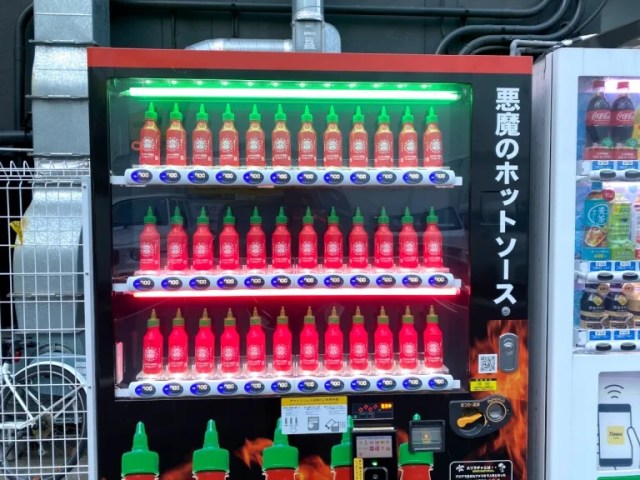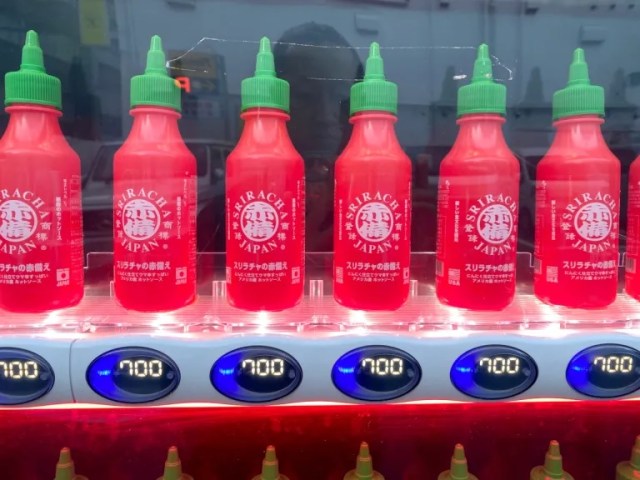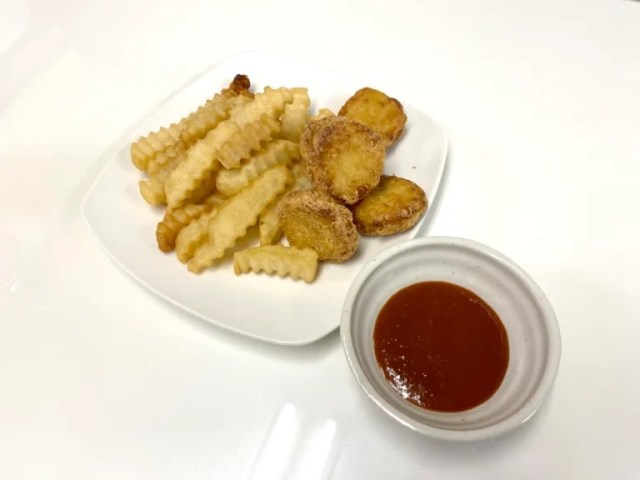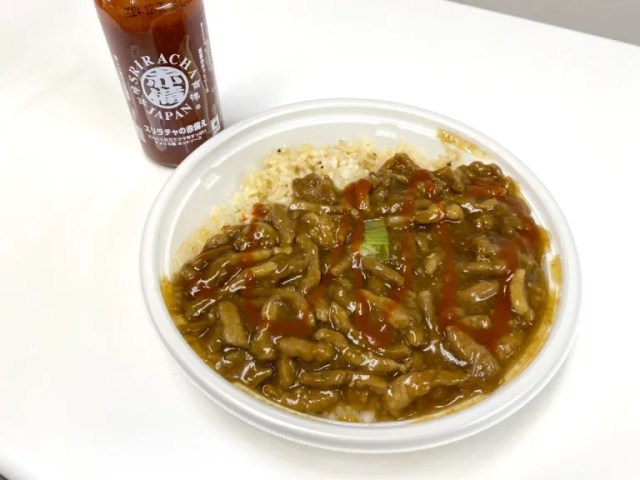
The hit hot sauce from overseas isn’t quite what he was expecting.
In our recent taste test of McDonald’s Japan’s shrimp nuggets, you might have noticed that one of the sauces we dipped them in was Sriracha. McDonald’s Japan doesn’t give out packets of the brand of spicy sauce made by Southern California’s Huy Fong Foods, however, and it’s still pretty hard to find in Japanese supermarkets too.
There has been an increase in Japan’s number of Sriracha vending machines, though. First appearing in the summer of 2021, they’ve since become quite a bit more numerous in the Tokyo, Nagoya, Osaka, and Fukuoka areas, as well as in Okinawa, as the map below shows.
Still, compared to normal drink vending machines, Sriracha ones are pretty uncommon. When you do pass by one, though, they’re very visible, due in no small part to their strips of neon green and red lights.
Having walked past a few of the machines, our Japanese-language reporter P.K. Sanjun, who’d never tried Sriracha before, decided to buy a bottle.
After feeding 700 yen (US$4.70) into the machine, he retrieved his purchase from the tray.
▼ The bottle comes packaged inside a tube that says “Delicious spicy hot sauce with garlic” in Japanese
Once he got home, P.K. decided to see how Sriracha would pair with four different foods, though he tested the first two, chicken nuggets and French fries, as a set, since they’re such a popular combination.
Using the Sriracha as a dip would give him the best idea of the flavor of the sauce’s seasoning power by itself, he figured. He noticed the strong garlic and sour notes, giving way to a spciy but clean finish. However, he was surprised at how he couldn’t detect even a trace of umami flavor, leaving him to think that as a solo seasoning Sriracha will give you a mix of garlic, spice, and sourness, but not much else.
Next up, ankake chahan, or fried rice with a thick, starch-based sauce. Ankake chahan is a staple at Chinese restaurants in Japan, somewhat similar to how Sriracha-brand sauce is a U.S. product with Thai inspirations.
When mixed in with the ankake sauce, P.K. was surprised at how mellow its spiciness became, though once again with a clean finish. He’d sort of expected Sriracha to be a super-fiery flavor, but that wasn’t turning out to be the case, and if you want to feel the heat with a Sriracha-enhanced ankake chahan, he suggests that you really pour the stuff on.
And last, it was time to test Sriracha with Cup Noodle.
When it was mixed in with Cup Noodle broth, P.K. could barely taste the Sriracha at all. Instant ramen broth tends to have very strong flavors, and they were easily overpowering the Sriracha. Not that the result tasted bad, Cup Noodle itself is tasty stuff, but it didn’t taste much different from Cup Noodle without Sriracha.
In the end, P.K. isn’t dissatisfied or disappointed with Sriracha, but he hasn’t found a combination that really shows him why it’s become so popular overseas. His current theory is that it probably works best with simpler recipes, things where there isn’t a lot else going on in the seasoning department, so that the Sriracha can play the leading role. As to what specific dishes those would be, he’s not sure yet, but without about half his bottle left he’s still got enough supplies for further experimentation.
Photos © SoraNews24
● Want to hear about SoraNews24’s latest articles as soon as they’re published? Follow us on Facebook and Twitter!
[ Read in Japanese ]







 Snow in Japan turns vending machine into ice-cold gacha game
Snow in Japan turns vending machine into ice-cold gacha game Mouth-watering customized Japanese cooking sauces offered by mail-order company
Mouth-watering customized Japanese cooking sauces offered by mail-order company Edible culture shock: Our Japanese reporter tries American barbecue for first time【Taste test】
Edible culture shock: Our Japanese reporter tries American barbecue for first time【Taste test】 “The most Delicious Cup Noodle in history” – Japan’s French Cup Noodle wins our heart【Taste test】
“The most Delicious Cup Noodle in history” – Japan’s French Cup Noodle wins our heart【Taste test】 Professional Chinese food chef teaches us how to make the perfect fried rice
Professional Chinese food chef teaches us how to make the perfect fried rice Japan’s new difficult-to-drink-from beer glass protects your liver, but it’s a brutal experience
Japan’s new difficult-to-drink-from beer glass protects your liver, but it’s a brutal experience New Nintendo Lego kit is a beautiful piece of moving pixel art of Mario and Yoshi【Photos】
New Nintendo Lego kit is a beautiful piece of moving pixel art of Mario and Yoshi【Photos】 Come play hide-and-seek on a deserted Japanese island this August and November
Come play hide-and-seek on a deserted Japanese island this August and November How to order snacks on a Shinkansen bullet train in Japan
How to order snacks on a Shinkansen bullet train in Japan New samurai glasses are Japan’s latest weird must-have souvenir
New samurai glasses are Japan’s latest weird must-have souvenir Caffeinated ramen for gamers that you can eat with one hand going on sale in Japan
Caffeinated ramen for gamers that you can eat with one hand going on sale in Japan Turns out you can draw all four original starter Pokémon with just three colored pencils【Video】
Turns out you can draw all four original starter Pokémon with just three colored pencils【Video】 Nintendo history you can feel – Super NES, N64, and GameCube controllers become capsule toys
Nintendo history you can feel – Super NES, N64, and GameCube controllers become capsule toys Demon Slayer: Kimetsu no Yaiba gets new roller coaster attractions and food at Universal Studios Japan
Demon Slayer: Kimetsu no Yaiba gets new roller coaster attractions and food at Universal Studios Japan Sailor Moon celebrates 30 years with beautiful purse, accessory lines from Samantha Group【Pics】
Sailor Moon celebrates 30 years with beautiful purse, accessory lines from Samantha Group【Pics】 Hello, cosmetics! Clinique teams up with Hello Kitty this summer for first-time collaboration
Hello, cosmetics! Clinique teams up with Hello Kitty this summer for first-time collaboration “The most Delicious Cup Noodle in history” – Japan’s French Cup Noodle wins our heart【Taste test】
“The most Delicious Cup Noodle in history” – Japan’s French Cup Noodle wins our heart【Taste test】 Starbucks releases a cute Frappuccino and Unicorn Cake…but not in Japan
Starbucks releases a cute Frappuccino and Unicorn Cake…but not in Japan Kyoto Tower mascot termination reveals dark side behind cute Japanese characters
Kyoto Tower mascot termination reveals dark side behind cute Japanese characters McDonald’s Japan’s Soft Twist Tower: A phantom ice cream only sold at select branches
McDonald’s Japan’s Soft Twist Tower: A phantom ice cream only sold at select branches Yabai Ramen: What makes this Japanese ramen so dangerous?
Yabai Ramen: What makes this Japanese ramen so dangerous? Finally! Nintendo Japan expands Switch 8-bit controller sales to everybody, Online member or not
Finally! Nintendo Japan expands Switch 8-bit controller sales to everybody, Online member or not Japanese government wants to build luxury resorts in all national parks for foreign tourists
Japanese government wants to build luxury resorts in all national parks for foreign tourists To combat declining birth rate, Japan to begin offering “Breeding Visas” to foreigners
To combat declining birth rate, Japan to begin offering “Breeding Visas” to foreigners 10 things you should buy at 7-Eleven in Japan
10 things you should buy at 7-Eleven in Japan Studio Ghibli releases anime heroine cosplay dresses that are super comfy to wear
Studio Ghibli releases anime heroine cosplay dresses that are super comfy to wear Woman charged for driving suitcase without a license in Osaka
Woman charged for driving suitcase without a license in Osaka Studio Ghibli unveils My Neighbour Totoro miniature house model
Studio Ghibli unveils My Neighbour Totoro miniature house model Kyoto experiencing problems with foreign tourists not paying for bus fares, but not on purpose
Kyoto experiencing problems with foreign tourists not paying for bus fares, but not on purpose Fighting mild hunger with a Japanese soda that turns into jelly in the stomach【Taste test】
Fighting mild hunger with a Japanese soda that turns into jelly in the stomach【Taste test】 Studio Ghibli’s Howl’s Moving Castle tapestry unveiled in Japan for first time
Studio Ghibli’s Howl’s Moving Castle tapestry unveiled in Japan for first time McDonald’s new Happy Meals offer up cute and practical Sanrio lifestyle goods
McDonald’s new Happy Meals offer up cute and practical Sanrio lifestyle goods Sales of Japan’s most convenient train ticket/shopping payment cards suspended indefinitely
Sales of Japan’s most convenient train ticket/shopping payment cards suspended indefinitely Sold-out Studio Ghibli desktop humidifiers are back so Totoro can help you through the dry season
Sold-out Studio Ghibli desktop humidifiers are back so Totoro can help you through the dry season Japanese government to make first change to romanization spelling rules since the 1950s
Japanese government to make first change to romanization spelling rules since the 1950s Foreigner’s request for help in Tokyo makes us sad for the state of society
Foreigner’s request for help in Tokyo makes us sad for the state of society Ghibli founders Toshio Suzuki and Hayao Miyazaki contribute to Japanese whisky Totoro label design
Ghibli founders Toshio Suzuki and Hayao Miyazaki contribute to Japanese whisky Totoro label design Doraemon found buried at sea as scene from 1993 anime becomes real life【Photos】
Doraemon found buried at sea as scene from 1993 anime becomes real life【Photos】 Tokyo’s most famous Starbucks is closed
Tokyo’s most famous Starbucks is closed Princesses, fruits, and blacksmiths: Study reveals the 30 most unusual family names in Japan
Princesses, fruits, and blacksmiths: Study reveals the 30 most unusual family names in Japan We ate all eight kinds of cold noodles from 7-Eleven and here’s our favourites【Taste test】
We ate all eight kinds of cold noodles from 7-Eleven and here’s our favourites【Taste test】 We get to be (probably) the first ever to try Nissin Cup Noodle’s latest creation: Gyoza ramen!
We get to be (probably) the first ever to try Nissin Cup Noodle’s latest creation: Gyoza ramen! Hokkaido, Osaka, and Fukuoka: Taste-testing McDonald’s oddly named Adult Regional Teriyaki burgers
Hokkaido, Osaka, and Fukuoka: Taste-testing McDonald’s oddly named Adult Regional Teriyaki burgers Sushi vinegar for your McDonald’s hamburger? We create the Japan dip sandwich【Taste test】
Sushi vinegar for your McDonald’s hamburger? We create the Japan dip sandwich【Taste test】 Dom Dom’s Squid Devil Burger is here to shake up the gourmet scene like a tokusatsu bad guy
Dom Dom’s Squid Devil Burger is here to shake up the gourmet scene like a tokusatsu bad guy Japan’s new bento has people talking and hearts burning because it’s all fried chicken skins
Japan’s new bento has people talking and hearts burning because it’s all fried chicken skins How to turn leftover tempura into fried rice (or why to buy all the takeout tempura you can)
How to turn leftover tempura into fried rice (or why to buy all the takeout tempura you can) Mint Pepsi for Yakisoba is coming to Japan, and we got to taste it before it goes on sale
Mint Pepsi for Yakisoba is coming to Japan, and we got to taste it before it goes on sale McDonald’s Japan releases Spicy Chicken McNuggets so spicy they’ll knock you out? 【Taste Test】
McDonald’s Japan releases Spicy Chicken McNuggets so spicy they’ll knock you out? 【Taste Test】 We shoot for stardom with Japanese restaurant’s 1,300-times-spicier-than-usual curry
We shoot for stardom with Japanese restaurant’s 1,300-times-spicier-than-usual curry Beat the heat with Japanese somen noodles dipped in Starbucks noodle sauce?!
Beat the heat with Japanese somen noodles dipped in Starbucks noodle sauce?! Nissin Cup Noodle flavours become Umaibo snacks, and we try every one of them
Nissin Cup Noodle flavours become Umaibo snacks, and we try every one of them McDonald’s releases Come on Baby New York Burgers in Japan…but where’s the N.Y. flavour?
McDonald’s releases Come on Baby New York Burgers in Japan…but where’s the N.Y. flavour? We try the new Gaming Cup Noodle and Gaming Curry Rice from Nissin
We try the new Gaming Cup Noodle and Gaming Curry Rice from Nissin Are the new shrimp nuggets from McDonald’s Japan better than chicken McNuggets?
Are the new shrimp nuggets from McDonald’s Japan better than chicken McNuggets? Uniqlo and Nissin team up to bring us HeatTech instant noodles
Uniqlo and Nissin team up to bring us HeatTech instant noodles
Leave a Reply